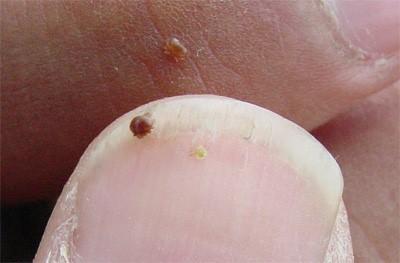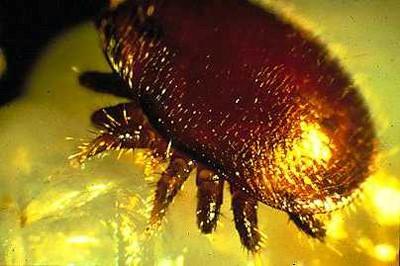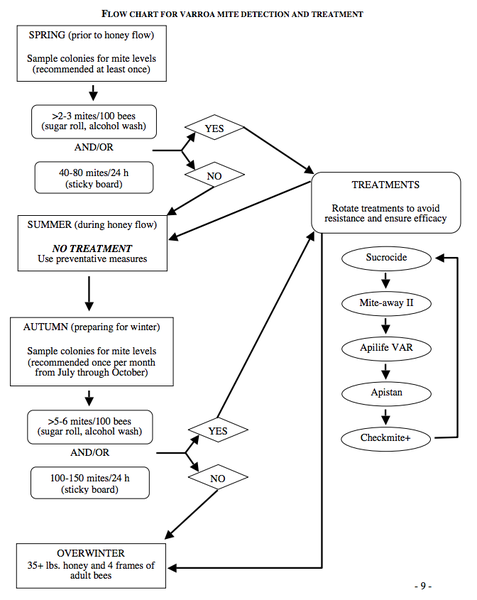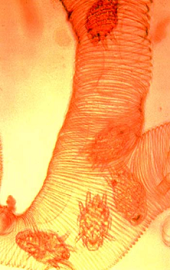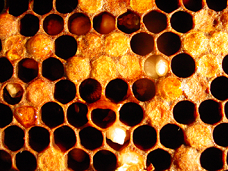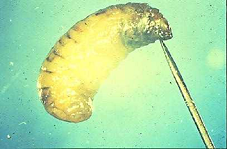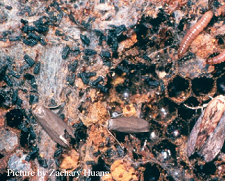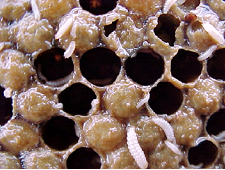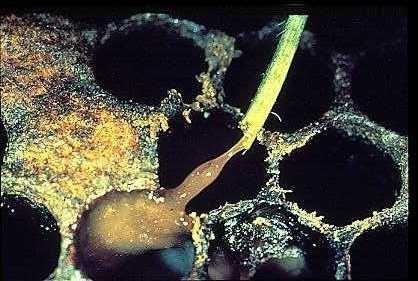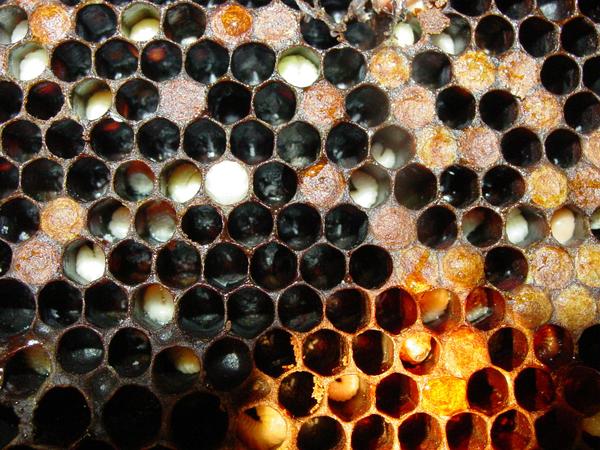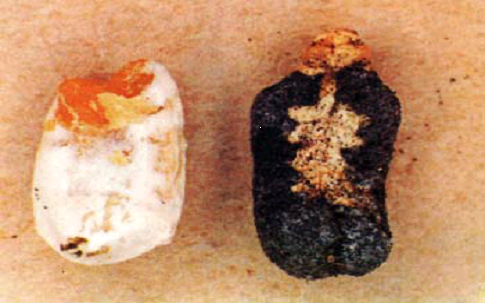Introduction
It is the goal of every beekeeper to maintain healthy, productive colonies. This can only be accomplished by reducing the frequency and prevalence of disease within beehives. The following is an outline of recommendations for detecting and treating colonies for economically important parasites and pathogens of honey bees so that beekeepers may achieve this goal, and do so in a sustainable way for the long-term health of their colonies.
| Disease/Pest | Causative Agent | Symptoms |
|---|---|---|
| Adult Parasites | ||
| Varroa mites | The parasitic mite Varroa destructor | Presence of adult mites, deformed wings |
| Tracheal mites | The parasitic mite Acarapis woodi | K-wings, morbidity |
| Vairimorpha (previously Nosema) | The microsporidian Vairimorpha apis | Diarrhea, distended abdomens |
| Brood Pathogens | ||
| American foulbrood (AFB) | The bacterium Paenibacillus larvae | Discolored larvae, foul smelling brood, ropy remains,hard scale |
| European foulbrood (EFB) | The bacterium Melissococcus pluton and associated flora | Discolored larvae, foul smelling brood, non-ropy remains, soft scale |
| Chalkbrood | The fungus Ascophaera apis | White or black mummies in cells or on bottom board |
| Sacbrood | A viral infection | Brown larvae in the curled "canoe" shape |
| Hive Pests | ||
| Wax moths | Larvae of Galaria mellonella | Silk cocoons and/or tunnels |
| Small hive beetle (SHB) | Larvae of Aethinda tumida | Wet combs, maggot-like larvae |
Varroa Mites
Cause
The parasitic mite, Varroa destructor.
Symptoms
- Presence of adult mites on adult bees, brood, or hive debris.
- Adults with shortened abdomens, misshapen wings, and deformed legs.
- Dramatic decline in adult population and brood area, with spotty brood pattern.
Means of prevention
- Mite-tolerant stocks, such as Russian, VSH, or Minnesota hygienic.
- Screened bottom boards.
- Drone-brood trapping.
Methods of detection
- Alcohol wash.
- Sugar shake.
- Sticky board. (Qualitative only)
- Drone-brood inspection or visual inspection. (Qualitative only)
Treatment recommendations (see flow chart)
Spring (prior to honey flow)
- If varroa levels are equal to or more than 2-3 mites per 100 adult bees (alcohol wash or sugar shake), control measures are warranted.
- The use of volatile treatments, such as thymol or formic acid, should be used with caution since they can result in decreased brood area.
Late spring/summer (during/immediately following honey flow)
- Never use any chemical control measures while honey supers are on hives.
- Employ one or more means of prevention, such as screened bottom boards or mite-tolerant stock.
Autumn (preparing for winter)
- Sample frequently for mites, at least once every 3 weeks.
- If varroa levels are equal to or more than 3 per 100 adult bees (alcohol wash or sugar shake), active control measures are warranted.
- Rotate control measures as often as possible to minimize the likelihood that the mites do not develop a resistance to any given control measure, which is particularly true for any chemical treatments.
For more information, see NC State Beekeeping Note 2.03, Varroa Mites, on the biology, detection, prevention, and treatment of varroa mite infestations.
Tracheal Mites
Cause
The parasitic mite, Acarapis woodi.
Symptoms
- There is no one tell-tale sign of this disease.
- Disjointed wings or ‘K-wing,’ distended abdomen.
- Bees often crawling on the bottom board appearing “morbid.”
Means of prevention
- Resistant stock, such as Russian.
Methods of detection
- Positive identification of tracheal mites can only be made upon microscopic observation of trachea (the breathing tubes of adult bees).
- While once common and highly problematic, most honey bees have developed a natural resistance to them and are fairly rare.
- If you suspect a tracheal-mite infestation, contact your regional NCDA&CS Apiary inspector.
Treatment recommendation
- Verify infestation level whenever tracheal mites are suspected (see above).
- If the percentage of infested adult workers is 10% or greater, active control is warranted. Treat colonies in the late summer or autumn.
- Recommended treatments:
- Mite-a-thol® (menthol crystals)
- Mite-Away II® (formic acid pads)
- Apilife VAR® (thymol pads) or Apigaurd® (thymol gel)
Vairimorpha (formerly Nosema)
Cause
The microsporidian, Vairimorpha apis or V. ceranae. The latter has largely displaced the former over the last few decades so that Vairimorpha ceranae is the most prevalent.
Symptoms
- There is no single symptom of the disease.
- Adults may have distended abdomens and defecate within the hive rather than take cleansing flights.
Means of prevention
- There is no exact means of prevention for nosema.
- Since the disease can be caused by stress, maintaining strong, healthy colonies is the best means of prevention.
Methods of detection
- Infections can only be confirmed by dissecting the digestive tract from individual bees. Diseased individuals have white, soft, and swollen ventriculae rather than brown and tubular.
- Hind gut contents can be examined under a microscope, and nosema spores can be counted using a hemocytometer.
Treatment recommendation
Spring (prior to honey flow)
- The only registered control measure for Vairimorpha is Fumadil-B®. Use if there are more than 1 million spores per bee.
- Mix Fumadil-B® with sugar syrup according to the label and feed to bees.
- New research has shown that Fumadil-B® is much less consistant in controlling V. ceranae than it was at controlling V. apis
Late spring/summer (during/immediately following honey flow)
- No treatment warranted. Maintain strong colonies.
Autumn (preparing for winter)
- Control if there are more than 1 million spores per bee.
- Mix Fumadil-B® with sugar syrup according to the label and feed to bees.
American Foulbrood
Cause
- The spore-forming bacterium, Paenibacillus larvae larvae.
Symptoms (see Table 1 below)
- Brood is dull white, becoming light brown to almost black.
- Age of dead brood is usually older sealed larvae or young pupae.
- Sealed brood is discolored and sunken, often with punctured cappings.
- Heavy infections have brittle, black scales that lie flat on the bottom of brood cells, formed from the dried remains of diseased brood. These scales contain billions of AFB spores and are highly contagious and persistent.
Means of prevention
- Hygienic stocks.
- Avoid robbing by keeping colonies strong.
- Minimize comb swapping between hives.
- Replace three combs in the brood chamber every year with foundation or drawn combs from honey supers.
- Minimize the sharing of beehive equipment or suspect frames to prevent cross-contamination.
- It is not recommended to preventatively treat colonies with antibiotics, as it masks AFB symptoms (increasing the spread of the disease among hives) and resistant strains of AFB may develop.
Methods of detection
- ‘Ropy test.’ Since larval remains of AFB-infected brood are elastic, a common field diagnostic is to pull the remains out of the cell with a toothpick or small twig. If the remains are elastic and “rope” out of the cell an inch or more, it is likely AFB rather than another brood disease.
- Holst milk test. This is a simple procedure that can be accomplished in most beekeeping operations. Place a suspect scale or smear of a diseased larva in a glass vial containing 4 ml of 1% powdered skim milk. Place the tube in a warm place (preferably at 37 ºC). If AFB is present, the suspension should be clear in 10-20 minutes, since P. larvae spores produce proteolytic enzymes.
- Other, more sophisticated tests can be performed in the laboratory. Contact your regional NCDA&CS Apiary inspector for details.
Treatment recommendations
- Verify infestation and distinguish from other brood diseases (see Table 1).
- Contact your regional NCDA&CS Apiary Inspector to inform them of an AFB outbreak.
- Burn all frames and euthanize bees.
- Scorch or fumigate empty brood boxes, bottom boards, inner covers, and lids.
European Foulbrood
Cause
- The bacterium Melissococcus pluton and associated flora.
Symptoms (see Table 1 below)
- Brood is dull white, becoming light brown to almost black.
- Age of dead brood is usually younger, unsealed larvae.
- Consistency of remains are rubbery and granular, not elastic.
Means of prevention
- EFB is largely a disease caused by stress. Thus maintaining a strong, healthy colony is the best prevention of the disease.
Methods of detection
- Visual inspection.
Treatment recommendations
-
Verify infestation and distinguish from other brood diseases (see Table 1).
-
For colonies with light infections, reduce the area of the brood nest, replace infected combs with foundation, and keep colony population strong.
- For colonies with heavy infections, use Terramycin® or other approved antibiotic according to the label. A veterinarian prescription is now rquired by the FDA in order to purchase and utilize antibiotics. Note that prophylactic use of any antibiotic is never recommended to avoid the evolution of resistance, and should only be applied as a last resort.
- For all cases, maintain a hive quarantine (i.e., do not exchange frames from or into the hive) and be vigilant for re-emergent signs of EFB.
Chalkbrood
Cause
- The fungus, Ascophera apis.
Symptoms (see Table 1 below)
- Hardened, white or black “mummies” that resemble the consistency of chalk.
- Mummies can be located in capped or uncapped brood cells, or they may litter the bottom board or on the ground directly outside the front entrance of a hive.
Means of prevention
- Chalkbrood is largely a disease caused by stress. Thus maintaining a strong, healthy colony is the best prevention of the disease.
- Chilling may also increase chalkbrood, so ensure that there is an adequate adult population to keep the brood nest warm during cold weather.
Methods of detection
- Through visual inspection, sympoms are fairly obvious, thus the presence of mummies is usually sufficient to confirm infection.
Treatment recommendations
- There are no chemotherapies for chalkbrood. Requeening may be beneficial.
Sacbrood
Cause
- A viral pathogen of bee larvae.
Symptoms (see Table 1 below)
- Dead larvae appear watery and granular with a thick skin that forms a sac.
- The head of an infected larva is lifted toward the top of the cell, resembling the shape of a canoe.
Means of prevention
- Sacbrood is largely a disease caused by stress. Thus maintaining a strong, healthy colony is the best prevention of the disease.
Methods of detection
- Visual inspection.
Treatment recommendations
- There are no chemotherapies for sacbrood. Requeening may be beneficial, and maintaining a strong colony often the best cure for the disease.
Wax Moths
Cause
- Larvae of the Galeria mellonella moth.
Symptoms
- Large, 1.5 inch larvae tunneling through the wax combs of weak hives or stored bee equipment.
- Silk cocoons, typically found on the side bars or top bars of frames in infested hives or equipment.
Means of prevention
- Maintain strong colonies and inspect weak colonies often.
- Cycle combs through the freezer for 1-2 days before storing.
- Place Paramoth® crystals (PDB) on stacks of stored combs according to the label.
- Certan(B402), which is a Bacillus thuringiensis (Bt) product, can be sprayed on stored combs as well.
Methods of detection
- Visual inspection.
Treatment recommendations
- Store unused combs with PDB crystals. Never place crystals on a living colony, as the fumes are highly toxic to adult bees and brood.
- If heavy infestations are found, freeze combs for 1-2 days before reusing.
Small Hive Beetle (SHB)
Cause
- Larvae of the beetle Aethinda tumida.
Symptoms
- Presence of adult beetles and eggs or larvae (presence of adults only does not necessarily indicate a problem).
- Watery, fermenting comb with small white grubs eating the wax.
- Larvae crawling out of the front entrance of the hive and burrowing into the soil.
Means of prevention
- The best means of prevention is to keep colonies strong so that the bees can police all areas of the nest, preventing egg-laying by the SHB and larval outbreaks.
- There are no chemical products that deter SHB infestation.
- Beekeeping supply stores sell various SHB traps that are placed inside the hive to reduce the number of adult beetles.
Methods of detection
- Visual inspection and verification of SHB larvae.
- Young wax moth larvae can sometimes be mistaken for SHB larvae. The two can be distinguished since SHB larvae have dorsal spines, whereas wax moth larvae do not.
Control recommendations
- The best control is to maintain a strong, healthy colony of honey bees.
- If adults are present, add one or more of the various traps designed to remove adult beetles from the hive before problems occur.
- The only registered treatment is a 1⁄2 a strip of Checkmite+® beneath a square of corrugated cardboard placed on the bottom board of the hive. However, this is no longer recommeded as it hasn't proven to be an effective control, and this can contaminate the wax comb. NOTE: the presence of Checkmite+® strips for the control of varroa mites does not simultaneously confer control for SHB.
- If larvae are present and crawling out of the hive:
- Replace infected combs with foundation, then burn them or freeze them if salvageable.
- Apply GuardStar® soil drench around the perimeter of the hive to kill developing pupae in the ground around the hive.
- There are currently no in-hive chemical treatments for SHB larvae.
For additional information about SHB biology, identification, prevention, and treatment, see NC State Beekeeping Note 2.05, The Small Hive Beetle.
Comparative Symptoms Table
| Symptom of dead brood | American foulbrood | European foulbrood | Chalkbrood | Sacbrood |
|---|---|---|---|---|
| Appearance of comb | Sealed brood is discolored and sunken, often with punctured cappings | Sealed brood is discolored and sunken, often with punctured cappings | Mummies found in sealed and unsealed brood | Scattered sealed brood with punctured cappings |
| Age | Usually older sealed larvae or young pupae | Usually young, unsealed larvae, but occasionally older coiled larvae | Older larvae in upright cells | Usually older sealed larvae upright in cells |
| Color | Dull white, becoming light brown, coffee brown, dark brown, then almost black | Dull white, becoming light brown, coffee brown, dark brown, then almost black | Chalk white or black | Grayish or straw-colored, becoming brown or darker |
| Consistency | Soft, becoming sticky to ropy | Watery and granular; rarely sticky or ropy | Hard and rocklike | Watery and granular; tough skin forms a sac |
| Odor | Slight to pronounced odor of gym socks | Slightly sour to penetratingly sour | Slight, non-objectionable | None to slightly sour |
| Scale characteristics | Hard, brittle, and black. Uniformly lies flat on lower side of cell. Adheres tightly. Fine, threadlike tongue of dead pupae may be present. | Usually twisted in cell. Does not adhere to cell wall. Rubbery and black. | Does not adhere to cell wall. Brittle and chalky, white to black in color. | Head prominently curled toward center of cell like a canoe. Does not adhere to cell wall. |
Product Control Chart
| Brand name
|
Type(s) of chemical
|
Varroa mites
|
Tracheal mites
|
Nosema
|
AFB/EFB
|
Wax moths
|
SHB
|
|---|---|---|---|---|---|---|---|
| Apigaurd
|
Thymol, an essential oils
|
X
|
X
|
-
|
-
|
-
|
-
|
| Apilife VAR
|
Blend of essential oils, particularly thymol
|
X
|
X
|
-
|
-
|
-
|
-
|
| Apistan
|
Fluvalinate, a synthetic pyrethroid
|
X
|
-
|
-
|
-
|
-
|
-
|
| Apivar | Amitraz, a synthetic miticide | X | - | - | - | - | - |
| Checkmite+
|
Coumaphos, an organophosphate
|
X
|
-
|
-
|
-
|
-
|
X
|
| Fumadil-B
|
Fumigilin, an antibiotic
|
-
|
-
|
X
|
-
|
-
|
-
|
| GardStar
|
Pemethrin, a synthetic pyrethroid
|
-
|
-
|
-
|
-
|
-
|
X
|
| Mite-a-thol
|
Menthol, an essential oil
|
-
|
X
|
-
|
-
|
-
|
-
|
| Mite-Away II
|
Formic acid, an organic biopesticide
|
X
|
X
|
-
|
-
|
-
|
-
|
| Paramoth
|
PDB crystals, a fumigant
|
-
|
-
|
-
|
-
|
X
|
-
|
| Terramycin
|
Oxy-tetracycline, an antibiotic
|
-
|
-
|
-
|
X
|
-
|
-
|
As always, use of non-approved chemical treatments is strictly prohibited, as are any applications of chemicals that do not follow the registered label.
Contact Information
North Carolina Department of Agriculture & Consumer Services, Apiary Inspection
North Carolina State University Apiculture Program
For more information on beekeeping, visit the Beekeeping Notes website.
|
David R. Tarpy |
Jennifer J. Keller |
Publication date: Jan. 19, 2021
Reviewed/Revised: Nov. 6, 2025
Recommendations for the use of agricultural chemicals are included in this publication as a convenience to the reader. The use of brand names and any mention or listing of commercial products or services in this publication does not imply endorsement by NC State University or N.C. A&T State University nor discrimination against similar products or services not mentioned. Individuals who use agricultural chemicals are responsible for ensuring that the intended use complies with current regulations and conforms to the product label. Be sure to obtain current information about usage regulations and examine a current product label before applying any chemical. For assistance, contact your local N.C. Cooperative Extension county center.
N.C. Cooperative Extension prohibits discrimination and harassment regardless of age, color, disability, family and marital status, gender identity, national origin, political beliefs, race, religion, sex (including pregnancy), sexual orientation and veteran status.

